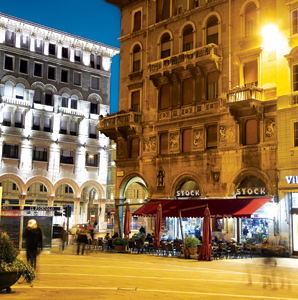
 It’s lunchtime in Trieste, the handsome Italian city on the Adriatic, and at Buffet Da Pepi, a genial crowd surges forward toward the serving station, lured by fresh pork simmering in fragrant broth. The steam rises. The three guys serving up the food resemble old-time countermen at a New York deli or maybe Tom Cruise as the bartender in Cocktail. The art is in the speed, the deft theatrical wielding of carving fork and knife as they haul the meat onto a marble slab, carve off slices of fresh pork, cured pork, ham, and cragno (sausage), toss some in a bun for a sandwich or onto a plate for a mixed platter.
It’s lunchtime in Trieste, the handsome Italian city on the Adriatic, and at Buffet Da Pepi, a genial crowd surges forward toward the serving station, lured by fresh pork simmering in fragrant broth. The steam rises. The three guys serving up the food resemble old-time countermen at a New York deli or maybe Tom Cruise as the bartender in Cocktail. The art is in the speed, the deft theatrical wielding of carving fork and knife as they haul the meat onto a marble slab, carve off slices of fresh pork, cured pork, ham, and cragno (sausage), toss some in a bun for a sandwich or onto a plate for a mixed platter.
With a side of crauti (sweet sauerkraut with caraway seeds), freshly grated cren (horseradish), and some mustard, lunch at Da Pepi alone makes the trip to Trieste worthwhile. I ask for a beer. Pierpaolo Segrè, my guide, suggests a glass of Terrano, the local red.
“This is what you could call a pig pub, and it is pure Trieste,” says Segrè, a third-generation Triestine who claims Italians, Dalmatians, Austrians, Hungarians, Catholics, and Jews among his recent ancestors, a mix as characteristically Triestine as the pork and the wine, followed by a black espresso at a tiny café where you stand up to drink your brew.
Segrè, like most natives, is a little obsessed with his city and thrilled that it’s currently got a buzz. Its tourist-office people eye the profoundly blue bay—dotted with sailboats and rimmed with beaches—they lick their lips and, in spite of the fact that Trieste is much more singular, grander, and more alluring than a mere coastal resort, pronounce the town “Portofino waiting to happen.”
After lunch, I try to walk off the pig, averting my eyes from the pastry shops, windows stuffed with Sacher torte, fruit tarts, pink and green almond cakes. In this compact city of about 200,000, you can walk almost everywhere. I wander. I climb the little hill to the Roman ruins, make my way to the Revoltella, once a rich merchant’s mansion, part of the house still intact, the rest a museum of modern art. Past the Teatro Lirico Giuseppe Verdi through grand squares and along winding cobblestoned backstreets, I head for the main square, and the sea, which stretches out in front of it.
Trieste’s location on the very edge of the Adriatic Sea has always defined it; it still does. As a modern city it was, in a sense, invented as a port town. From the 1380’s to World War I, Trieste belonged to the Hapsburgs—it was Vienna’s main route to the sea and the rest of the world.
Sitting in the Piazza dell’Unità d’Italia, I watch a spiffy blue and white ferry on its daily run. It seems about to sail straight into Trieste’s main square. The sea is the piazza’s fourth side, and you can almost taste the salt as speedboats bounce over the water. In summer, bronzed bodies in tiny bikinis lie on beaches just outside the town; in early fall, during the Barcolana regatta, the bay is so heavily dappled with white sails you feel you can almost walk out over it.
Everything in Trieste leads to the piazza; this is the city’s beating heart, its living room. On three sides are the massive buildings of imperial ambition, built between the early 19th and 20th centuries. The government palace, town hall, and the insurance and shipping companies make this an open-air architectural museum and provide a snapshot of the city’s roots in commerce and culture, of its sense of self. (read more at Travel & Leisure)